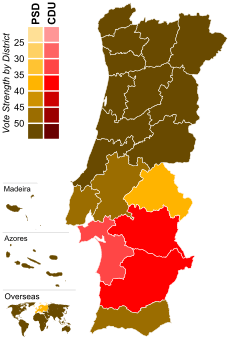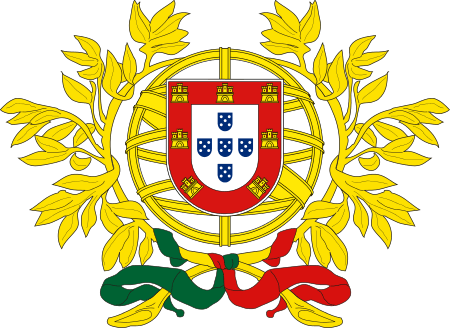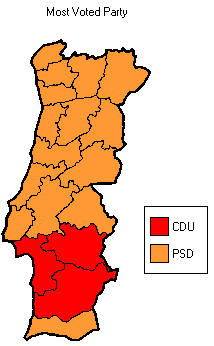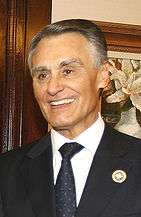1987 Portuguese legislative election
The Portuguese legislative election of 1987 took place on 19 July. In the previous election, in 1985, the Social Democratic Party had won a minority government managing to survive in coalition with the Democratic and Social Center and the Democratic Renewal Party, and after the approval of a no-confidence motion from the left-wing parties, with the aid of the Democratic Renewal Party, the government fell and Mário Soares, the President at the time, called for a new election.
| ||||||||||||||||||||||||||||||||||||||||||||||||||||||||||||||||||||||||||||||||||||||
250 seats to the Portuguese Assembly 125 seats needed for a majority | ||||||||||||||||||||||||||||||||||||||||||||||||||||||||||||||||||||||||||||||||||||||
|---|---|---|---|---|---|---|---|---|---|---|---|---|---|---|---|---|---|---|---|---|---|---|---|---|---|---|---|---|---|---|---|---|---|---|---|---|---|---|---|---|---|---|---|---|---|---|---|---|---|---|---|---|---|---|---|---|---|---|---|---|---|---|---|---|---|---|---|---|---|---|---|---|---|---|---|---|---|---|---|---|---|---|---|---|---|---|
| Registered | 7,930,668 | |||||||||||||||||||||||||||||||||||||||||||||||||||||||||||||||||||||||||||||||||||||
| Turnout | 5,676,358 (71.6%) | |||||||||||||||||||||||||||||||||||||||||||||||||||||||||||||||||||||||||||||||||||||
| ||||||||||||||||||||||||||||||||||||||||||||||||||||||||||||||||||||||||||||||||||||||
 Results by district or autonomous region. | ||||||||||||||||||||||||||||||||||||||||||||||||||||||||||||||||||||||||||||||||||||||
| ||||||||||||||||||||||||||||||||||||||||||||||||||||||||||||||||||||||||||||||||||||||
| This article is part of the series: |
| Politics and government of Portugal |
|---|
 |
| Portugal |
The PSD was elected to a landslide majority government—the biggest that a Portuguese party had ever won in a free election. Although the PSD was very popular going into the election, the size of its victory far exceeded the party's most optimistic expectations. The left-wing Democratic Unity Coalition lost some of its MPs to the Socialist Party and the Democratic Renovator Party lost almost all of its influence, mainly due to its responsibility in the fall of the former government. The right-wing Democratic and Social Center lost almost half of its vote share, due to the effect of tactical voting for the also right-wing, Social Democratic Party.
European elections were held on the same day.
Electoral system
The Assembly of the Republic has 250 members elected to four-year terms. Governments do not require absolute majority support of the Assembly to hold office, as even if the number of opposers of government is larger than that of the supporters, the number of opposers still needs to be equal or greater than 126 (absolute majority) for both the Government's Programme to be rejected or for a motion of no confidence to be approved.[3]
The number of seats assigned to each district depends on the district magnitude.[4] The use of the d'Hondt method makes for a higher effective threshold than certain other allocation methods such as the Hare quota or Sainte-Laguë method, which are more generous to small parties.[5]
Parties
The major parties involved and the respective leaders:
- Democratic Unity Coalition (CDU), Álvaro Cunhal
- Socialist Party (PS), Vítor Constâncio
- Democratic Renewal Party (PRD), Ramalho Eanes
- Social Democratic Party (PSD), Cavaco Silva
- Democratic and Social Center (CDS), Adriano Moreira
Aníbal Cavaco Silva, leader of the Social Democratic Party, was nominated Prime Minister.
Campaign period
Party slogans
| Party or alliance | Original slogan | English translation | Refs | |
|---|---|---|---|---|
| PSD | « Portugal não pode parar » | "Portugal can't stop" | [6] | |
| PS | « A alternativa » | "The alternative" | [7] | |
| CDU | « CDU, É melhor para Portugal » | "CDU, It's better for Portugal" | [8] | |
| PRD | « Agora Portugal » | "Now Portugal" | [9] | |
| CDS | « Vote prá maioria » | "Vote for the majority" | [10] | |
Candidates' debates
No debates between the main parties were held as the PSD leader and Prime Minister, Aníbal Cavaco Silva, refused to take part in any debate.[11]
Opinion Polling
The following table shows the opinion polls of voting intention of the Portuguese voters before the election. Those parties that are listed are currently represented in parliament. Included is also the result of the Portuguese general elections in 1985 and 1987 for reference.
| Date Released | Polling Firm | PSD | PS | CDU | PRD | CDS | Others | Lead | |
|---|---|---|---|---|---|---|---|---|---|
| 19 Jul 1987 | Leg. Election | 50.2 148 seats |
22.2 60 seats |
12.1 31 seats |
4.9 7 seats |
4.4 4 seats |
6.2 0 seats |
28.0 | |
| 19 Jul | RTP1 | 48.0–50.0 | 21.0–23.0 | 12.5–14.5 | 5.0–7.0 | 3.0–5.0 | – | 27.0 | |
| 19 Jul | Antena1 | 45.0–47.0 | 24.0–25.0 | – | – | – | – | 21.0–22.0 | |
| Exit polls | |||||||||
| 17 Jul | Euroexpansão/Expresso | 41.0–44.0 | 22.0–25.0 | 13.0–15.0 | 11.0–14.0 | 4.0–6.0 | – | 19.0 | |
| 1987 | |||||||||
| 6 Oct 1985 | Leg. Election | 29.9 88 seats |
20.8 57 seats |
15.5 38 seats |
17.9 45 seats |
10.0 22 seats |
5.9 0 seats |
9.1 | |
National summary of votes and seats
 | ||||||||||
| Parties | Votes | % | ± | MPs | MPs %/ votes % | |||||
|---|---|---|---|---|---|---|---|---|---|---|
| 1985 | 1987 | ± | % | ± | ||||||
| Social Democratic | 2,850,784 | 50.22 | 88 | 148 | 59.20 | 1.18 | ||||
| Socialist | 1,262,506 | 22.24 | 57 | 60 | 24.00 | 1.08 | ||||
| Democratic Unity Coalition[A][B] | 689,137 | 12.14 | 38 | 31 | 12.40 | 1.02 | ||||
| Democratic Renewal | 278,561 | 4.91 | 45 | 7 | 2.80 | 0.57 | ||||
| Democratic and Social Centre | 251,987 | 4.44 | 22 | 4 | 1.60 | 0.36 | ||||
| People's Democratic Union | 50,717 | 0.89 | 0 | 0 | 0.00 | 0.0 | ||||
| Revolutionary Socialist | 32,977 | 0.58 | 0 | 0 | 0.00 | 0.0 | ||||
| Portuguese Democratic Movement | 32,607 | 0.57 | N/A | N/A | 0 | N/A | 0.00 | N/A | 0.0 | |
| Christian Democratic | 31,667 | 0.56 | 0 | 0 | 0.00 | 0.0 | ||||
| People's Monarchist | 23,218 | 0.41 | N/A | N/A | 0 | N/A | 0.00 | N/A | 0.0 | |
| Portuguese Workers' Communist | 20,800 | 0.37 | 0 | 0 | 0.00 | 0.0 | ||||
| Communist Party (Reconstructed) | 18,544 | 0.33 | 0 | 0 | 0.00 | 0.0 | ||||
| Workers Party of Socialist Unity | 9,185 | 0.16 | 0 | 0 | 0.00 | 0.0 | ||||
| Total valid | 5,552,690 | 97.82 | 250 | 250 | 100.00 | — | ||||
| Blank ballots | 50,135 | 0.88 | ||||||||
| Invalid ballots | 73,533 | 1.30 | ||||||||
| Total (turnout 71.57%) | 5,676,358 | 100.00 | ||||||||
| A In 1985, as United People Alliance. B Portuguese Communist Party (29 MPs) and "The Greens" (2 MPs) ran in coalition.[12] | ||||||||||
| Source: Comissão Nacional de Eleições | ||||||||||
Distribution by constituency
| Constituency | % | S | % | S | % | S | % | S | % | S | Total S |
|---|---|---|---|---|---|---|---|---|---|---|---|
| PSD | PS | CDU | PRD | CDS | |||||||
| Azores | 66.7 | 4 | 20.0 | 1 | 2.3 | - | 3.0 | - | 3.3 | - | 5 |
| Aveiro | 60.4 | 11 | 22.9 | 4 | 4.4 | - | 2.7 | - | 5.3 | - | 15 |
| Beja | 24.5 | 1 | 20.3 | 1 | 38.7 | 3 | 5.7 | - | 2.0 | - | 5 |
| Braga | 53.4 | 10 | 25.9 | 5 | 6.1 | 1 | 3.3 | - | 5.9 | 1 | 17 |
| Bragança | 60.8 | 3 | 19.2 | 1 | 3.2 | - | 1.3 | - | 7.6 | - | 4 |
| Castelo Branco | 52.1 | 4 | 22.4 | 2 | 7.1 | - | 6.0 | - | 4.7 | - | 6 |
| Coimbra | 50.0 | 6 | 28.7 | 4 | 7.2 | 1 | 3.5 | - | 4.5 | - | 11 |
| Évora | 32.1 | 2 | 15.4 | - | 36.2 | 2 | 7.7 | - | 2.1 | - | 4 |
| Faro | 46.7 | 5 | 24.9 | 3 | 10.9 | 1 | 6.3 | - | 3.1 | - | 9 |
| Guarda | 60.0 | 4 | 21.8 | 1 | 3.3 | - | 2.0 | - | 6.6 | - | 5 |
| Leiria | 60.8 | 9 | 18.7 | 2 | 5.9 | - | 3.0 | - | 6.0 | - | 11 |
| Lisbon | 45.8 | 28 | 21.2 | 12 | 16.5 | 10 | 6.9 | 4 | 3.7 | 2 | 56 |
| Madeira | 65.5 | 4 | 16.2 | 1 | 1.9 | - | 3.3 | - | 5.2 | - | 5 |
| Portalegre | 37.4 | 1 | 25.1 | 1 | 20.9 | 1 | 6.3 | - | 3.1 | - | 3 |
| Porto | 50.9 | 22 | 26.7 | 11 | 9.4 | 4 | 4.0 | 1 | 4.0 | 1 | 39 |
| Santarém | 47.9 | 7 | 21.7 | 3 | 12.6 | 1 | 7.3 | 1 | 3.6 | - | 12 |
| Setúbal | 32.6 | 6 | 17.6 | 3 | 32.7 | 7 | 8.7 | 1 | 1.9 | - | 17 |
| Viana do Castelo | 54.5 | 5 | 20.3 | 1 | 6.3 | - | 4.8 | - | 7.7 | - | 6 |
| Vila Real | 62.5 | 5 | 20.3 | 1 | 4.1 | - | 1.4 | - | 5.0 | - | 6 |
| Viseu | 64.1 | 8 | 17.9 | 2 | 2.9 | - | 1.7 | - | 7.0 | - | 10 |
| Europe | 37.0 | 1 | 28.4 | 1 | 15.9 | - | 4.9 | - | 6.6 | - | 2 |
| Rest of the World | 63.2 | 2 | 7.3 | - | 1.4 | - | 1.7 | - | 19.9 | - | 2 |
| Total | 50.2 | 148 | 22.2 | 60 | 12.1 | 31 | 4.9 | 7 | 4.4 | 4 | 250 |
| Source: Comissão Nacional de Eleições | |||||||||||
Maps

.png) Most voted political force by municipality.
Most voted political force by municipality.
References
- Assembleia da República - Deputados e Grupos Parlamentares
- Assembleia da República - Deputados e Grupos Parlamentares
- "Constitution of the Portuguese Republic" (PDF). Archived from the original (PDF) on 2016-03-03. Retrieved 2019-12-29.
- "Effective threshold in electoral systems". Trinity College, Dublin. Retrieved 2015-10-21.
- Gallaher, Michael (1992). "Comparing Proportional Representation Electoral Systems: Quotas, Thresholds, Paradoxes and Majorities"
- "ELEIÇÕES LEGISLATIVAS DE 1987 – PSD". EPHEMERA (in Portuguese). Retrieved 11 May 2020.
- "Evolução da Comunicação Política e Eleitoral em Portugal" (in Portuguese). Retrieved 11 May 2020.
- "ELEIÇÕES LEGISLATIVAS DE 1987 – CDU – AUTOCOLANTES". EPHEMERA (in Portuguese). Retrieved 11 May 2020.
- "Campanha eleitoral do PRD". RTP (in Portuguese). Retrieved 11 May 2020.
- "ELEIÇÕES LEGISLATIVAS DE 1987 – CDS". EPHEMERA (in Portuguese). Retrieved 11 May 2020.
- "O que mudam os debates na TV". Correio da Manhã (in Portuguese). 4 September 2009. Retrieved 11 May 2020.
- "Electoral results - Assembly of the Republic". Archived from the original on 2012-07-16. Retrieved 2012-09-02.
Further reading
- David B. Goldey, "The Portuguese elections of 1987 and 1991 and the presidential election of 1991." Electoral Studies 11.2 (1992): 171–176.

_(cropped).jpg)
.jpg)
_(cropped).png)
